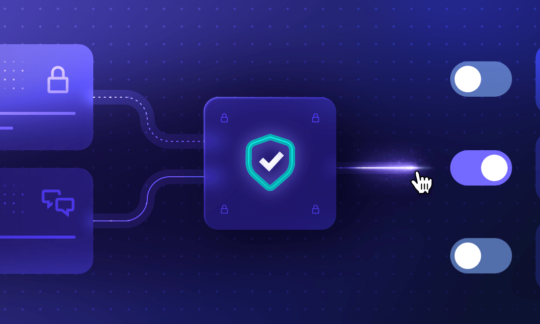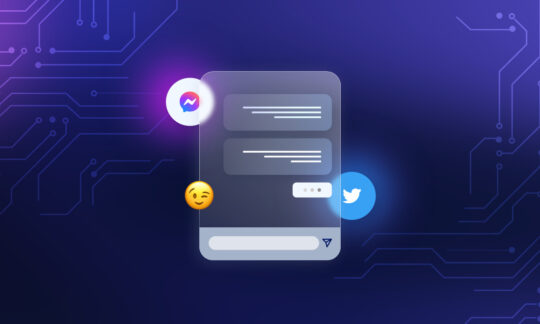How to Manage an AI Chatbot Project – 10 Tips to Help You Get Started
Table of contents
- Consider the Business Use Cases for Your Chatbot
- Choose Communication Channels Your Customers Prefer
- Set the KPIs for Your Project
- Consider Rule-Based or Conversational AI Chatbots
- Evaluate the Benefits of On-Premise and Cloud-Based Hosting
- Define the Target Audience
- Define Processes to Automate
- Consider Potential Security Risks and How to Avoid Them
- Get Your Company on Board
- Choose the Right Partner for Your Bot-Building Platform
- Article Summary
Welcome to our blog series, AI Bots – A Manager’s Handbook. The series provides comprehensive guidance to help you successfully plan, initiate, and deliver a chatbot project for your corporation. Our intent was to create a useful resource for professionals in charge of launching a chatbot/voice bot project in order to improve organisational business processes and demonstrate the value of conversational AI to their stakeholders.
A study by CCW Digital found that 80% of organisations are looking for ways to implement chatbots. There are many examples of chatbots delivering measurable value across many industries. And now, you have been tasked with implementing a chatbot in your company. Whether the decision comes from C-level management, the company-wide objective of driving digital transformation, or the necessity for cost optimisation, it is up to you to lead this project. Now what?
An important first step, before the first document is created or the first project huddle, is to carefully consider some who/what/why questions that can help provide clarity for your objectives and intended outcomes. Below, we’ve coined 10 important points to consider before kicking off an AI chatbot project.
1. Consider the Business Use Cases for Your Chatbot
Which department is paying for your conversational AI project? Which department is your chatbot going to support? If you have one department willing to foot the bill, and seven other departments lined up to use your chatbot, you’re heading into a political mess already – and we’re only on the first of 10! Unless you want to be running between teams the whole project, trading one department’s feature off against another’s, you’ll need a cross-department project steering group to keep things on the rails. Having clear decision-making accountability in this forum will help you get the right leaders talking and provide key stakeholders with ongoing communication.
Chatbots usually have the most compelling ROI in a customer service scenario, but they can also provide substantial business benefits in support of Marketing, Sales, and HR, among others. As you talk with potential project stakeholders, build out short use cases for each benefit. Will your chatbot implementation:
- Provide self-service options for customers?
- Provide real-time FAQ info to reps while they handle calls?
- Support client transactions such as money transfers?
- Nurture and qualify leads?
- Drive promotions and upselling to existing clients?
- Support employees through knowledge sharing and process automation?
Once you’ve collected and evaluated the potential of the various use cases, it will most likely determine whether your chatbot is information-oriented or task-oriented. Information-oriented bots use knowledge bases to surface answers to common questions from customers. Task-oriented bots are usually integrated with customer systems, allowing them to perform account-specific tasks like checking account balances, submitting a payment, or tracking an order. Ideally, your chatbot will do both; an end-to-end solution can provide information responses and help customers complete tasks.
2. Choose Communication Channels Your Customers Prefer
The best method for choosing communication channels for your chatbot is to analyse data from your customer base, your target markets, and internal sources. You want to understand the digital channels your customers use most often.
Having a text-based chatbot is usually a default choice, but what about voice? You may be able to gather some useful proxy data by observing which companies in your industry have introduced voice bots and how it impacted their business.
The next set of choices gets more difficult as you look beyond webchat on your corporate website and consider social media platforms or third-party apps like Slack or Skype for Business. You’ll find useful information in our article, “The best communication channels for chatbots.” Channel usage can vary wildly by region. For example, China has over 827 million WeChat users, while India has 487 million WhatsApp users. It’s important to research and understand the digital preferences of your market, and most importantly, the preferences of your customers.
3. Set the KPIs for Your Project
We dive deeper into chatbot KPIs in a subsequent article in this series. Before the project begins, you should have a view of what success looks like and how to measure it.
As you walk through the use cases of your bot, try to jot down the most critical metric to measure, and some supporting metrics. Some commonly measured KPIs for chatbots include:
- Automation rate (call deflection): What percentage of customer inquiries are successfully resolved by your bot without needing escalation to a human rep? An underlying measure here would be your chatbot’s intent accuracy, the ability to successfully resolve issues.
- Reduction of waiting times: Wait time can be a huge factor for customer satisfaction, so be sure you collect baseline data prior to your chatbot implementation. This will allow you to illustrate the before-and-after comparison later on.
- Customer satisfaction: Not only can your bot help improve customer satisfaction and NPS scores, it can also help collect the customer input that these measures are based on.
- Number of resolved tickets: This statistic illustrates the cumulative value of your bot for customer service. An underlying metric might be the number of issues escalated to a human rep.
- Lead generation: Chatbots can help qualify and nurture leads. If your chatbot is included as a lead source in your CRM, you can track those leads through to conversions and sales.
- Incremental Sales (Upselling): With the ability to surface promotional offers to customers, you can track success rates and sales volume of campaigns introduced by your chatbot.
4. Consider Rule-Based or Conversational AI Chatbots
Your chatbot implementation strategy doesn’t need to include all the technical requirements. That can come later in consultation with a working group and your chosen chatbot provider. But there is one important fork in the road to consider, as it will significantly impact the capabilities you need: do you need a rule-based chatbot, or a conversational AI chatbot?
Conversational bots have more sophisticated natural language processing capabilities, allowing them to handle a far greater range of queries. Rule-based bots follow a pre-built workflow (decision tree) the user follows to get answers to their most commonly asked questions. For more, read our detailed breakdown: Conversational AI Bots vs Rule-Based Chatbots: Pros, Cons & Use Cases.
5. Evaluate the Benefits of On-Premise and Cloud-Based Hosting
Your chatbot implementation project plan will inevitably need to address hosting. With cloud-based hosting, your chatbot provider will own the infrastructure and store the data for your chatbot. With an on-premise installation, the chatbot server and data are maintained within your company’s network infrastructure.
Most corporations have faced this decision many times in recent years, and it’s likely that your network operations team will have a clear policy, precedent, and preference to share. Generally, companies that are larger, highly regulated, and dealing with highly sensitive personal information (e.g., banks, insurance companies) will have a strong preference for on-premise solutions.
6. Define the Target Audience
AI chatbot development is most successful when there is a clear audience in mind. Whether your chatbot audience is external or internal, it’s valuable to build a representative profile of your user base. This persona can include a range of dimensions, including:
- Language: Chatbots can interpret and respond in over 100 languages, but you should focus your training time on the languages most likely to be used.
- Demographics: Factors like age and location can help round out your persona.
- Communication style: Formal? Casual? Technical?
- Digital aptitude: Assessing the technical savvy of your audience allows you to tailor the responses of your bot to suit your audience’s needs.
7. Define Processes to Automate
Chatbot project management requires a firm grasp of project direction and scope control. To ensure that your chatbot delivers maximum value, it’s important to prioritise the most valuable processes to automate. You’ll likely need to do some digging to develop a prioritised list.
The fastest track to understanding the most common customer needs and issues can often be found in the high-volume tickets from your customer support team. You may have customer support silos in your organisation, so consider all the channels the customers use for feedback including web contact forms, public-facing email accounts, and social media channels.
Once you have a prioritised list, organise a workshop to make sure there’s alignment between teams and that the most important client needs are met. This early collaboration will be the first of many steps as you introduce your chatbot to your company.
8. Consider Potential Security Risks and How to Avoid Them
We’ve written about the broad range of security risks associated with chatbots, including inaccuracy, potential data exposure, and unconscious bias. Some methods of mitigating these risks include:
- On-premise or private cloud deployment: Hosting your chatbot within your organisation’s network infrastructure provides your company with full control over security, access, and performance optimisation.
- Authentication and authorisation: Using biometric scans or two-factor authentication to verify user identities.
- Message encryption: For channels that support it, end-to-end encryption is ideal for ensuring that only authorised employees can see any chat message delivered to via your bot.
9. Get Your Company on Board
Let’s face it – not everyone welcomes change, and as the ambassador for AI transformation in your company, you may face some resentment or pushback. The best approach is to illustrate the value that your conversational AI project will bring.
For customer service teams, a chatbot handling the most repetitive and routine tasks will free customer service reps to focus on more complex, higher-value tasks. As a result:
- Their job will be less repetitive
- They will handle a lower volume of tickets each day
- They can devote their time to providing above-and-beyond service to clients
Additionally, a chatbot or a voice bot can help increase your company’s revenue (e.g.,when used in upselling or lead generation) and save operational costs (e.g., reduced call times, fewer errors).
Another aspect of getting company buy-in is ensuring you have a skilled and dedicated team. You’ll need an initial team that understands chatbot development methodology and how to build a chatbot. You’ll also need resources devoted to ongoing management and optimisation of your chatbot. It’s important to articulate these resource needs early in the project.
10. Choose the Right Partner for Your Bot-Building Platform
The platform you choose for building your bot can have a huge impact on the success of your AI chatbot project. Today’s bot-building platforms reduce the need for deep technical expertise. They surface complex capabilities through intuitive, low-code/no-code bot-building interfaces. We’ve compiled some additional tips for choosing the right bot platform.
Why SentiOne Automate might be perfect for you:
- Our powerful NLU engine delivers 94% intent accuracy recognition
- Our low-code/no-code platform has an intuitive UI, which makes it easy for non-technical bot designers to create conversation flows
- You can create chatbots and voicebots simultaneously
- Automated testing capabilities can drastically reduce the manual testing effort
- Easy integrations with digital channels and business systems (e.g. CRM)
To learn more about SentiOne Automate, book a demo for a first-hand look at our bot-building capabilities.
Article Summary
This article introduces AI Bots – A Manager’s Handbook Series. It emphasises the growing demand for chatbots and the need to carefully plan before initiating a project. The article offers 10 important tips to consider, including defining business use cases, selecting communication channels, setting KPIs, choosing between rule-based and conversational AI chatbots, evaluating hosting options, defining the target audience, automating processes, addressing security risks, gaining company buy-in, and choosing the right bot-building platform.



